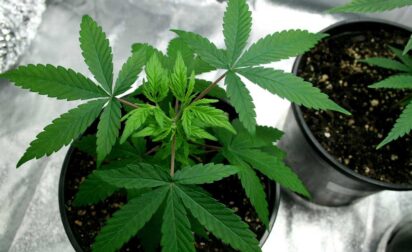
Are You 18 Or Over?
YesOr
No By clicking yes, you certify that you are over 18. By using this website, you agree to our legal disclaimer.605+ Cannabis Strains over 20 Breeders worldwide.
Table of Contents

The Cannabis genus originated somewhere in Asia over 12,000 years ago and has ever since spread across all the different continents. Nowadays, these plants have evolved enormously thanks to us, humans. Marijuana breeders have combined different species over the years to create totally new strains of plants.
One of the biggest evolution was the feminization of cannabis plants. This is quite a breakthrough in the complex world of marijuana because only female flowers produce actual psychoactive effects. After years of crossing different plants, breeders have found a way to create plants that have a 99% chance to be a female.
So, how do we create female plants? First, we need to know how to tell the difference between a male and a female cannabis plant.
Cannabis plants go through two stages, the vegetative phase, and the flowering phase. In the vegetation stage, it is close to impossible to tell the plant’s gender. Plants spend all their efforts on growing bigger and taller during this stage.
Once the plants switch to its flowering phase, they focus on growing flowers. At this point, we can now tell whether a plant is male or female. Male weed plants have grape-like balls, which look like a cluster of small flowers, that open up to produce pollen. They do not have any pistils on them. If the male is allowed to continue to grow, theses balls or pollen sacs will eventually burst open and let their pollen out.
Female plants are easy to recognize, as the first thing you’ll see is at least one or two wispy white hairs or pistils protruding from their calyxes. All cannabis growers are after these female weeds because they produce the buds that contain the most THC concentration and rich cannabinoid profiles. Having a garden of unpollinated females means a continuous supply of psychoactive nuggets.
Now that we have understood the process of identifying a male vs. a female cannabis plant, we need to know how to possibly grow all-female weeds from seeds on every plant, every time.
When growing marijuana from seeds, you will only have lesser chances of getting female seeds as, statistically, regular cannabis produces 75% or more male seeds per crop. In order to increase our chances of getting up to 99% feminized seeds, here are some techniques and tricks of the trade that many experienced breeders swear on.
The stability of the growing environment is important to increase the chances of getting a female plant from your crop. Studies have shown that environmental stress tends to produce more males and lesser females. A stable environment covers all the essential requirements needed to grow a marijuana plant. This includes temperatures, humidity, light cycles, and nutrient feedings.
As soon as the seed has its first few pairs of leaves, influencing the settings to have lower temperatures and higher humidity will contribute to an increase in female development. Once these have been set, both temperatures and humidity in air and soil should have as few fluctuations as possible. A humidity level of at least 70% to 80% RH is the ideal level for healthy female plants. This ensures that the growing medium does not dry out too much or becomes too soggy and drenched with water. Either way, the plant will become stressed, and this will encourage more male development.
As the plants grow to become pubescent plants, make sure to adjust the humidity levels to an exact 70% RH. Using the necessary tools like a humidifier or dehumidifier and a hygrometer will ensure that we are able to maintain stable conditions.
Once the plant reaches its flowering stage, adjust the levels gradually to reach 40% to 50% RH. The keyword here is “gradually.” An abrupt change will, needless to say, stress the plants and result in problems for the cannabis flowers.
Lightcycles should also be maintained at the same length every day and basically should begin and end at the same time. While it is always tempting to expose the plants to more hours of light to encourage faster growth, studies have shown that longer hours of daylights tend to produce more males. On the contrary, fewer hours of daylight will increase the likelihood of females developing.
For your cannabis plants, exposing them to nothing more than a 14-6 day-night photoperiod will maximize the chances of females. Some breeders may opt to increase this to an 18-6 light cycle, and add an extra week of vegetation, as shorter day length slows the growth of the plants. The 18-6 photoperiod is still acceptable as long as they do not go over 18 hours. Otherwise, the likelihood of males increases by as much as 70% to 100%. Patience during the vegetative phase is greatly rewarded.
Natural light may appear white to us, but it is actually made up of different colors. And cannabis plants are influenced on how to grow based on the spectrum of light that they receive. Red lights increase the likelihood of male plants, while blue lights encourage female development. Blue lights include white and blue fluorescent lights and metal halide lamps. They are blue based on their spectrum and imitate the natural light we get during spring and summer times more effectively.
Plants use mineral nutrients, including nitrogen and potassium, to grow. Cannabis breeders develop specific nutrient programs for their plants to influence their plants’ shape, size, potential, and even gender. By increasing nitrogen levels slightly and decreasing potassium, cannabis growers can increase the likelihood of female development. Additionally, nutrient mixes should be exact on every feeding, especially during the vegetative phase, as any sudden spikes or dips in the mixes will cause stress on the cannabis plants.
Following these simple and easy-to-follow tips will maximize female cannabis development, but it does not work every single time. However, surveys have shown that it does work 99% of the time, which is still a pretty good number. The general idea here is to grow regular seeds in a resource-efficient and stress-free way in order to get female weeds all the time.

[ez-toc] In indoor gardening, maintaining an optimal temperature within your grow tent is crucial for the health and productivity of your plant

[ez-toc] Welcome to the delightful world of cannafudge crafting, where sweetness meets sophistication, and cannabis infusion adds a unique twis

[ez-toc] You’ve finished trimming your weed, but what about those leftover stems? Don’t throw them away! These seemingly useless bits can a

Feeling high can be an exhilarating experience, but it's essential to make the most of it by engaging in activities that enhance the sensation a

[ez-toc] Starting with planting cannabis seeds might seem simple, but how deep should cannabis seeds be planted for them to grow well. In this

[ez-toc] In the realm of cultivating cannabis, maximizing growth during the flowering stage is a top priority for growers. While various method

[ez-toc] Nutrient burn is a common issue among plant enthusiasts, often resulting from over-fertilization or improper nutrient application. It

[ez-toc] Welcome to our complete guide to dealing with harmful pathogenic mold in cannabis. For those who grow cannabis, preventing mold is vit

In recent years, there has been speculation about “did Shakespeare smoke weed?” This idea originates from a study by South African anthropol

[ez-toc] Welcome to the hidden world beneath the soil – the inside of the marijuana root system. While the vibrant leaves and resinous flower

Are You 18 Or Over?
YesOr
No By clicking yes, you certify that you are over 18. By using this website, you agree to our legal disclaimer.